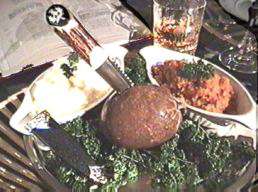Address
to A Haggis
This
famous poem by Burns is regularly recited during celebrations throughout
the World, whenever Haggis makes an appearance on the menu ! Yet for many,
some basic questions may need an answer.
What
is a Haggis?
Back
Well, without wanting to disappoint anyone….it is NOT the mythical
furry creature,…… with its two inside legs shorter than its
two outside legs..…to allow it to run easily along hillsides ! Nor
is it any kind of living creature.
A Haggis is a
very old Scottish dish, which combines meats, spices and oatmeal to create
a very rich, unusual, but none the less delicious feast. The factual and
historic description of Haggis is sometimes off-putting to people who
have not tried it. Fortunately, modern techniques in the preparation and
presentation of Haggis make it an acceptable delicacy to almost everyone's
palate. In fact, its simply delicious. If you haven't tried haggis …..authentic
Scottish Haggis…..you must ! Whilst here in Scotland it is not consumed
on a daily basis, it does feature regularly on many peoples home menus
throughout the year. It makes "guest" appearances on a more
formal basis throughout the year, whenever Scottish culture is celebrated.
ARRRRRGH
!!!
In the olden days the preparation of a Haggis went something like this
:-
Take the liver, lungs & heart of a sheep and boil them. Mince the
meats and mix with chopped onions, toasted oatmeal, salt, pepper, and
spices. Take one properly cleaned sheep's stomach. Stuff the cleaned stomach
with the prepared contents. Sew up the stomach (leaving enough room for
expansion to avoid a large messy explosion) and boil. Serve and eat. Lovely
!
 Okay!,
now you've returned from the bathroom, be reassured that modern Haggis
prepared here in Scotland is not so gruesome. The best meats are selected,
(including tripe and offal) and prepared with finest oatmeal and spices…..but
served in a synthetic skin which is representative of the old technique.
The quality manufacturers of Haggis here in Scotland pride themselves
in their guarded secret recipes and prepare the Haggis to exacting standards.
Haggis has a higher quality of content than your average "sausage"…..and
is extremely healthy…..so please don't be put off! Nowadays, there
are even vegetarian versions made from the finest Scottish produce. Okay!,
now you've returned from the bathroom, be reassured that modern Haggis
prepared here in Scotland is not so gruesome. The best meats are selected,
(including tripe and offal) and prepared with finest oatmeal and spices…..but
served in a synthetic skin which is representative of the old technique.
The quality manufacturers of Haggis here in Scotland pride themselves
in their guarded secret recipes and prepare the Haggis to exacting standards.
Haggis has a higher quality of content than your average "sausage"…..and
is extremely healthy…..so please don't be put off! Nowadays, there
are even vegetarian versions made from the finest Scottish produce.
So
now that you know about Haggis, what are its origins?
In the days when hunting was a means of basic survival, all parts of the
dead animal had to be used. The skins were used as clothing, the gut and
tissue used as thread for sewing, with the main carcass and organs used
as food. The bulk content meat was often dried or salted and proved suitable
for a long "shelf life" The innards and organs of the beast were the most
perishable parts and had to be consumed first.
Someone, somewhere, sometime, recognised that the stomach made an excellent
cooking vessel, and that mixing the organs with spices and meal, placing
them in this natural "pot" and cooking the contents provided a highly
nutritional and tasty meal. This basic method of cooking has been traced
back to Greek and Roman times.
The name "Haggis" however has its origins in more recent history and links
are shown to Scandinavian "hag" meaning to "hew" or the French "hageur"
- "to cut" or German "hackwurst" meaning "minced sausage" Who knows !
It is difficult to identify exactly when the great Scottish "haggis" as
described by Burns, came to be. For sure, in his day, and during the 18th
century, the now famous meal was regularly served in Scotland as a tasty,
and very healthy meal. It is only from here in Scotland that you can savour
a genuine Scottish haggis !
Why
did Burns write about the Haggis?
Back
This is an interesting question and I doubt if we will ever know exactly
what inspired him to write The Address To A Haggis. What is clear however,
is that Burns was presenting the Haggis as being a unique and symbolic
part of Scottish identity and culture. Through the power of the spoken
word and the imagery of vivid language, Rabbie successfully portrayed
a picture in the mind, which has long since become the focal point of
the celebration of Burns and Scotland.
When written, only a short time had passed since the Jacobite Rebellion.
The French Revolution was alive, and America was in the aftermath of the
War of Independence. In Britain, the political struggle between Scotland
and England was very much to the fore and Burns wrote passionately on
the subject.
So war, political struggle, and the Scottish identity were the catalyst
for the poem. The humble Haggis was merely the vehicle used to demonstrate
his proud Scottish nationalism, which he does in a light-hearted way.
Burns clearly thought that Haggis was a great meal but he also recognised
its nutritional value, its popularity and its unusual preparation and
presentation. It was uniquely Scottish.
It is therefore easy to see why Rabbie made the link between Scotland's
Identity at that time, and the serving of Haggis to ordinary Scots, as
an ordinary Scottish meal. I suppose it was a strange subject to write
about but this is the mastery of Burns!
What
does the Address to a Haggis mean?
Back
|
| Address
To A Haggis
Fair fa' your honest, sonsie
face,
Great chieftain o' the puddin-race!
Aboon them a' ye tak your place,
Painch, tripe, or thairm:
Weel are ye wordy o' a grace
As lang's my arm.
The groaning trencher there ye fill,
Your hurdies like a distant hill,
Your pin wad help to mend a mill
In time o' need,
While thro' your pores the dews distil
Like amber bead.
His knife see rustic Labour dight,
An' cut you up wi' ready sleight,
Trenching your gushing entrails bright,
Like ony ditch;
And then, O what a glorious sight,
Warm-reekin, rich!
Then, horn for horn,
they stretch an' strive:
Deil tak the hindmost! on they drive,
Till a' their weel-swall'd kytes belyve,
Are bent lyke drums;
Then auld Guidman, maist like to rive,
"Bethankit!" 'hums.
Is there that owre his French ragout
Or olio that wad staw a sow,
Or fricassee wad mak her spew
Wi' perfect sconner,
Looks down wi' sneering, scornfu' view
On sic a dinner?
Poor devil! see him ower his trash,
As feckless as a wither'd rash,
His spindle shank, a guid whip-lash,
His nieve a nit;
Thro' bloody flood or field to dash,
O how unfit!
But mark the Rustic, haggis fed,
The trembling earth resounds his tread.
Clap in his walie nieve a blade,
He'll mak it whissle;
An' legs an' arms, an' heads will sned,
Like taps o' thrissle.
Ye Pow'rs wha mak mankind your care,
And dish them out their bill o' fare,
Auld Scotland wants nae skinking ware
That jaups in luggies;
But, if ye wish her gratefu' prayer,
Gie her a haggis!
|
The
Translation
Fair is your honest happy
face
Great chieftain of the pudding race
Above them all you take your place
Stomach, tripe or guts
Well are you worthy of a grace
As long as my arm
The groaning platter there you fill
Your buttocks like a distant hill
Your skewer would help to repair a mill
In time of need
While through your pores the juices emerge
Like amber beads
His knife having seen hard labour wipes
And cuts you up with great skill
Digging into your gushing insides bright
Like any ditch
And then oh what a glorious sight
Warm steaming, rich
Then spoon for spoon
They stretch and strive
Devil take the last man, on they drive
Until all their well swollen bellies
Are bent like drums
Then, the old gent most likely to rift (burp)
Be thanked, mumbles
Is there that over his French Ragout
Or olio that would sicken a pig
Or fricassee would make her vomit
With perfect disgust
Looks down with a sneering scornful opinion
On such a dinner
Poor devil, see him over his trash
As week as a withered rush (reed)
His spindle-shank a good whiplash
His clenched fist.the size of a nut.
Through a bloody flood and battle field to dash
Oh how unfit
But take note of the strong haggis fed Scot
The trembling earth resounds his tread
Clasped in his large fist a blade
He'll make it whistle
And legs and arms and heads he will cut off
Like the tops of thistles
You powers who make mankind your care
And dish them out their meals
Old Scotland wants no watery food
That splashes in dishes
But if you wish her grateful prayer
Give her a haggis!
|
|
Why
is Haggis served during Scottish cultural celebrations?
Back
Following the
death of Burns, a number of Burns Clubs were formed to celebrate and honour
his memory..and what better than to serve the great Haggis during this
celebration, and to recite his famous Address to a Haggis.
This custom has been carried through the years and has now become firmly
established as one of the key recitals at any Burns Supper , celebrated
by millions throughout the world.
All manner of Scottish celebrations choose to have Haggis on their menu.
It is a truly excellent choice for such occasions and almost everyone
who tries it..loves it ! There is nothing better than real, authentic,
Scottish haggis, served traditionally with "neeps n tatties" At home with
the family, entertaining guests, or at organised events..go for Haggis
!
Burns wrote the poem as a celebration of Scotland and all things Scottish.
In some ways it is quite strange and rather amusing to think that one
of the worlds greatest poets, should write so passionately about a simple
meal. Rabbie himself, would no doubt find the celebrity status of the
Haggis hilarious, particularly since he is responsible for that fame!
All in all, it is very fitting that the humble Scottish Haggis has continued
and prospered in modern society, and has itself now become representative
of Scotland.
Mac
The World Burns Club
Back
Address
to a Haggis in our poem archive
|

 Okay!,
now you've returned from the bathroom, be reassured that modern Haggis
prepared here in Scotland is not so gruesome. The best meats are selected,
(including tripe and offal) and prepared with finest oatmeal and spices…..but
served in a synthetic skin which is representative of the old technique.
The quality manufacturers of Haggis here in Scotland pride themselves
in their guarded secret recipes and prepare the Haggis to exacting standards.
Haggis has a higher quality of content than your average "sausage"…..and
is extremely healthy…..so please don't be put off! Nowadays, there
are even vegetarian versions made from the finest Scottish produce.
Okay!,
now you've returned from the bathroom, be reassured that modern Haggis
prepared here in Scotland is not so gruesome. The best meats are selected,
(including tripe and offal) and prepared with finest oatmeal and spices…..but
served in a synthetic skin which is representative of the old technique.
The quality manufacturers of Haggis here in Scotland pride themselves
in their guarded secret recipes and prepare the Haggis to exacting standards.
Haggis has a higher quality of content than your average "sausage"…..and
is extremely healthy…..so please don't be put off! Nowadays, there
are even vegetarian versions made from the finest Scottish produce.